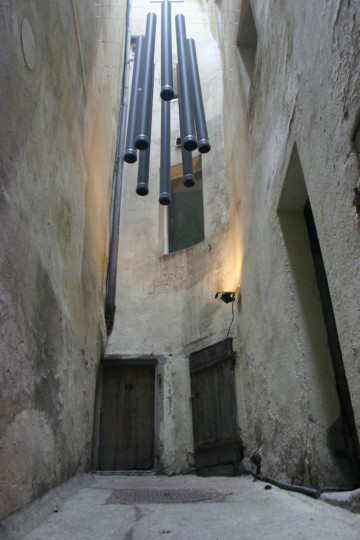Nicolas Vionnet
SILENCE
March 18, 2011 – April 30, 2011
Vionnet’s preferred medium is acrylic on canvas. His chiefly large-scale works play with space and expanse. Although almost always realistic, his paintings have more in common with abstract images than real landscapes. He paints disruptive grey strips across his clouds and allows coloured surfaces to drip down the canvas in accordance with the laws of gravity.
Vionnet is fascinated by such irritations: interventions that approach and create a non-hierarchical dialogue with the environment. This dialogue opens up a field of tension, which allows the viewer an intensive glimpse of both these phenomena.
Vionnet uses the same approach and the same strategy for his installations. Irritation and integration. A fundamental confrontation with the history of a place leads to a subtler and more precise intervention of the object.
Take for example his man-made grass island at the Weimarhallen Park, which ironically intensified the park’s own artificiality. In ‘Close the Gap’ he bridged the space between an old-town row of houses with a printed canvas image of the now much frowned upon prefabricated building. A reference to changes in time and aesthetics.
Vionnet consulted the original function of the Ehegraben for his ‘Silence’ installation. This part of the building was used to direct sewage and rubbish away from the surrounding houses and into the river Limmat. This swilling system was made defunct by advances in hygiene and the introduction of a sewage network at the beginning of the 20th century, which increased the population’s quality of life immensely. The days of nasal pollution caused by the daily emptying of cesspits and stinking quagmires were over. Sewage has flowed quietly and unseen through our cities ever since. No noise, no smell.
‘Silence’ makes visible and audible that which is normally buried below the ground’s surface. Playfully, yet irritatingly, in the footsteps of his own tradition, Vionnet puts before our eyes that which the Ehegraben once was. Waste pipes now hang in the Ehegraben on thin wires like wind chimes. The amount of rubbish that collected in these ditches at that time is now hinted at by the huge size of these pipes in this narrow space.
Vionnet is fascinated by such irritations: interventions that approach and create a non-hierarchical dialogue with the environment. This dialogue opens up a field of tension, which allows the viewer an intensive glimpse of both these phenomena.
Vionnet uses the same approach and the same strategy for his installations. Irritation and integration. A fundamental confrontation with the history of a place leads to a subtler and more precise intervention of the object.
Take for example his man-made grass island at the Weimarhallen Park, which ironically intensified the park’s own artificiality. In ‘Close the Gap’ he bridged the space between an old-town row of houses with a printed canvas image of the now much frowned upon prefabricated building. A reference to changes in time and aesthetics.
Vionnet consulted the original function of the Ehegraben for his ‘Silence’ installation. This part of the building was used to direct sewage and rubbish away from the surrounding houses and into the river Limmat. This swilling system was made defunct by advances in hygiene and the introduction of a sewage network at the beginning of the 20th century, which increased the population’s quality of life immensely. The days of nasal pollution caused by the daily emptying of cesspits and stinking quagmires were over. Sewage has flowed quietly and unseen through our cities ever since. No noise, no smell.
‘Silence’ makes visible and audible that which is normally buried below the ground’s surface. Playfully, yet irritatingly, in the footsteps of his own tradition, Vionnet puts before our eyes that which the Ehegraben once was. Waste pipes now hang in the Ehegraben on thin wires like wind chimes. The amount of rubbish that collected in these ditches at that time is now hinted at by the huge size of these pipes in this narrow space.

